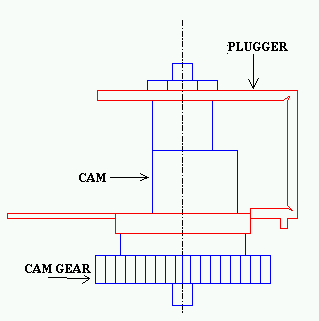1. DIAL
It is a circular plastic disc with small circles cut along its periphery , through the finger can be passed to actuate the diallling. The sheet of numbers is pasted to the base below it , which remains fixed.
It further provides a limit to the dial by becoming tightly wound around the
shaft.
It is a system of two gears mounted on a single shaft. The smaller one acts as the pinion to the MAIN GEAR
while the larger transmits this motion to the
CAM GEAR
and the REDUCER GEAR.The pinion has 11 teeth
and the gear has 64 teeth.
.
4. TRANSMISSION GEAR
The cam gear consists of a gear and a cam on acommon shaft. The gear meshes with the TRANSMISSION GEAR
while the cam transmits the pulse motion to the electrical contacts.
The plugger manifests itself in holding one of the electrical plates fixed, so that the motion of other would lead to an alternating loss and maintenance of contact.
The cam gear has 28 teeth.
5.CAM GEAR & PLUGGER
